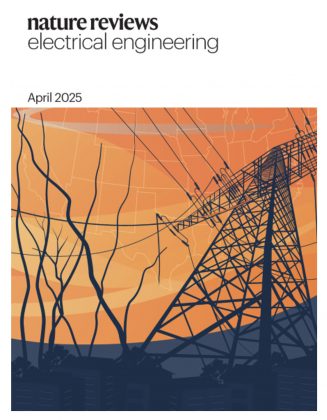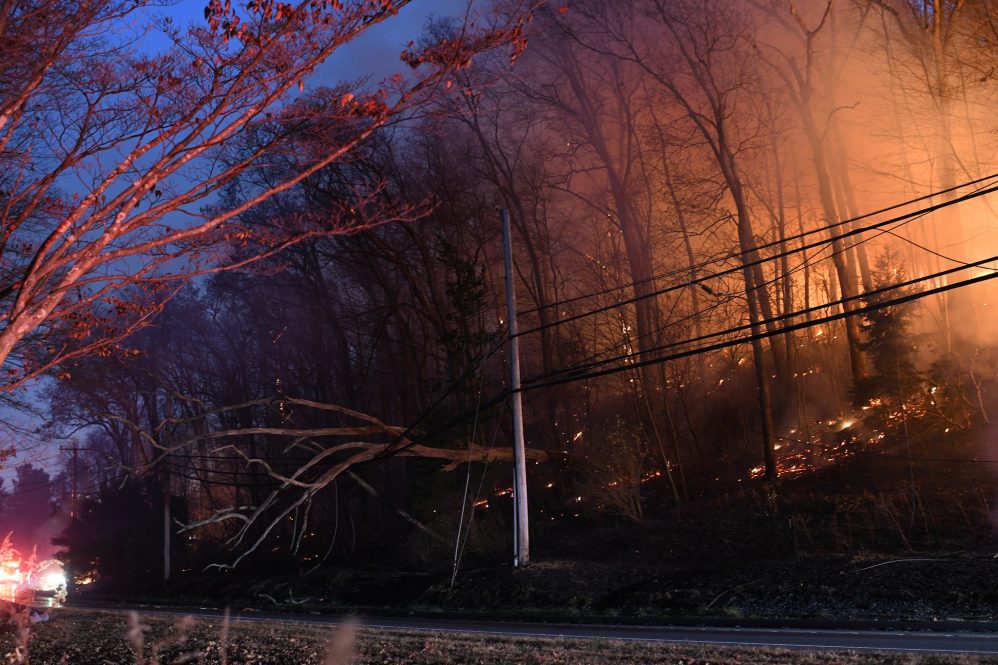It’s a harsh irony.
During a wildfire, firefighters depend on electricity to communicate, power emergency response, and keep hospitals running. But the electric grid is also one of the leading causes of the very fires they are working to contain.

“Power lines can ignite fires in several ways,” says Junbo Zhao, Castleman Term Professor in engineering innovation and director of the Department of Energy Northeast University Cybersecurity Center for Advanced and Resilient Energy Delivery (CyberCARED). “High winds can knock down poles or cause wires to clash and spark. Overgrown vegetation can brush against live wires. Aging infrastructure, such as decades-old transmission lines, can fail under stress.”
These events, combined with drought, rising temperatures, fuel buildup, and a surge in ignition sources create a “perfect storm” for fire outbreaks, he says.
In a recently published Nature Reviews Electrical Engineering article, principal investigator Zhao and several colleagues unpack the growing connection between wildfires and power grid vulnerabilities in the face of changing climate. As wildfires become more intense and frequent—especially across the western United States—their destructive link to power grids is becoming more apparent.
At the same time, firefighting efforts often require shutting down parts of the grid, leading to widespread outages and economic losses.
Between 2014 and 2024, downed power lines accounted for 60 percent of California’s wildfires, including the 2018 Camp Fire that killed 85 people and destroyed the town of Paradise. A nearly 100-year-old transmission line was determined to be the fire’s cause.
More recently, the 2024 Smokehouse Creek Fire in Texas—the largest in the state’s history—burned nearly 1 million acres after a decayed utility pole snapped during high winds. Downed power lines are suspected to be the culprit of the 2023 fires in Lahaina, Hawaii. which killed over 100 people.

“Strengthening the power grid resilience to storms and wildfires through advanced sensing and AI technology is critical to assuring reliable power during extreme weather and security events, which is more important than ever due to climate change,” says Emmanouil Anagnostou, Board of Trustees Distinguished Professor and executive director of the Institute of Environment and Energy. “Research at the Eversource Energy Center advances leading-edge technology on fire ignition modeling and global monitoring of fire severity from space-based sensors, which can support preparedness and inform near-real-time emergency response.”
Zhao and Anagnostou, along with Fangni Lei, assistant research professor of civil and environmental engineering; UConn research assistant Soroush Vahedi; Ph.D. candidate Kang He; and other authors from Sandia National Laboratory, the University of California Santa Barbara, and Lawrence Berkeley National Laboratory emphasize the urgent need for a comprehensive and collaborative approach to strengthen power grid resilience against the rising threat of wildfires.
In Nature Reviews, they suggest a three-phase resilience strategy that involves understanding wildfire risks, developing detailed planning and mitigation strategies, and ensuring effective implementation and ongoing evaluation.
The initial phase involves identifying high-risk regions and vulnerable infrastructure, integrating climate change data into wildfire models to improve risk assessment and long-term infrastructure planning. Accurate projections of wildfire impacts on system components—such as power lines and transformers—are critical for designing targeted, climate-adaptive responses.
In the second phase, the focus shifts to developing actionable strategies for prevention, real-time mitigation, and recovery. This includes hardening infrastructure through undergrounding lines, enhancing protection systems, and managing vegetation to reduce ignition risks. Real-time monitoring technologies, remote sensing, and improved situational awareness are central to effective mitigation, while operational enhancements—like optimized grid management and emergency response coordination—support overall system resilience. Planning also incorporates predictive analytics to guide de-energization decisions and firefighting efforts.

The final phase involves putting strategies into practice through detailed action plans, financial investment, and regular evaluations. Evaluating the effectiveness of resilience measures requires setting clear benchmarks and timelines.
Looking ahead, the researchers stress the importance of integrating dynamic vegetation and advanced and granular weather models to forecast risk conditions and inform preventive actions.
“Further investments in R&D and the development of real-time operational risk management systems will be essential to ensure grid stability, safety, and adaptability in an era of increasing wildfire threats,” Zhao says.



